Critical Appraisal of a Nursing Journal Article: NUM1204 Assignment 2
VerifiedAdded on 2022/09/30
|11
|2934
|17
Report
AI Summary
This report critically appraises the research article "Incidence, severity and risk factors of peripheral intravenous cannula-induced complications: An observational prospective study" by Simin et al. The study, published in the Journal of Clinical Nursing, investigated complications associated with peripheral venous cannulation (PVC). The appraisal examines the article's title, authors, abstract, literature review, methodology (including data collection and sampling), data analysis, results, and conclusion. The study employed an observational prospective design, collecting data from 1,428 PVC insertions among 368 adult patients in a tertiary healthcare clinic. The report assesses the credibility of the authors, the comprehensiveness of the literature review, and the appropriateness of the research methods. Key findings, such as the prevalence of phlebitis and infiltration, are discussed alongside the limitations of the study, including the single-clinic setting and potential biases. The report also evaluates the ethical considerations and the generalizability of the results, concluding with an assessment of the study's implications for clinical practice and suggestions for future research. The report highlights the use of standardized instruments, statistical procedures, and the presentation of results using STROBE guidelines.
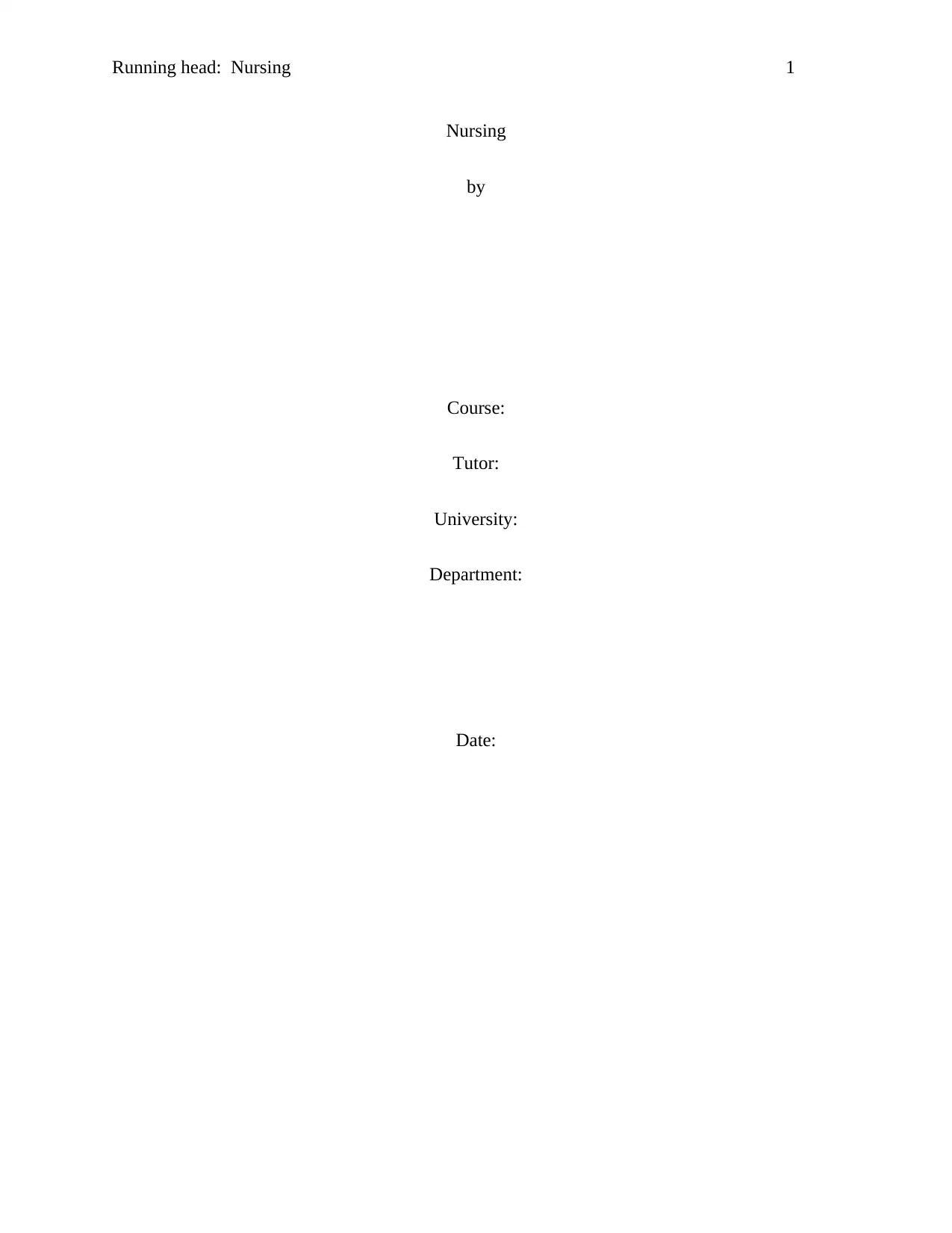
Running head: Nursing 1
Nursing
by
Course:
Tutor:
University:
Department:
Date:
Nursing
by
Course:
Tutor:
University:
Department:
Date:
Paraphrase This Document
Need a fresh take? Get an instant paraphrase of this document with our AI Paraphraser
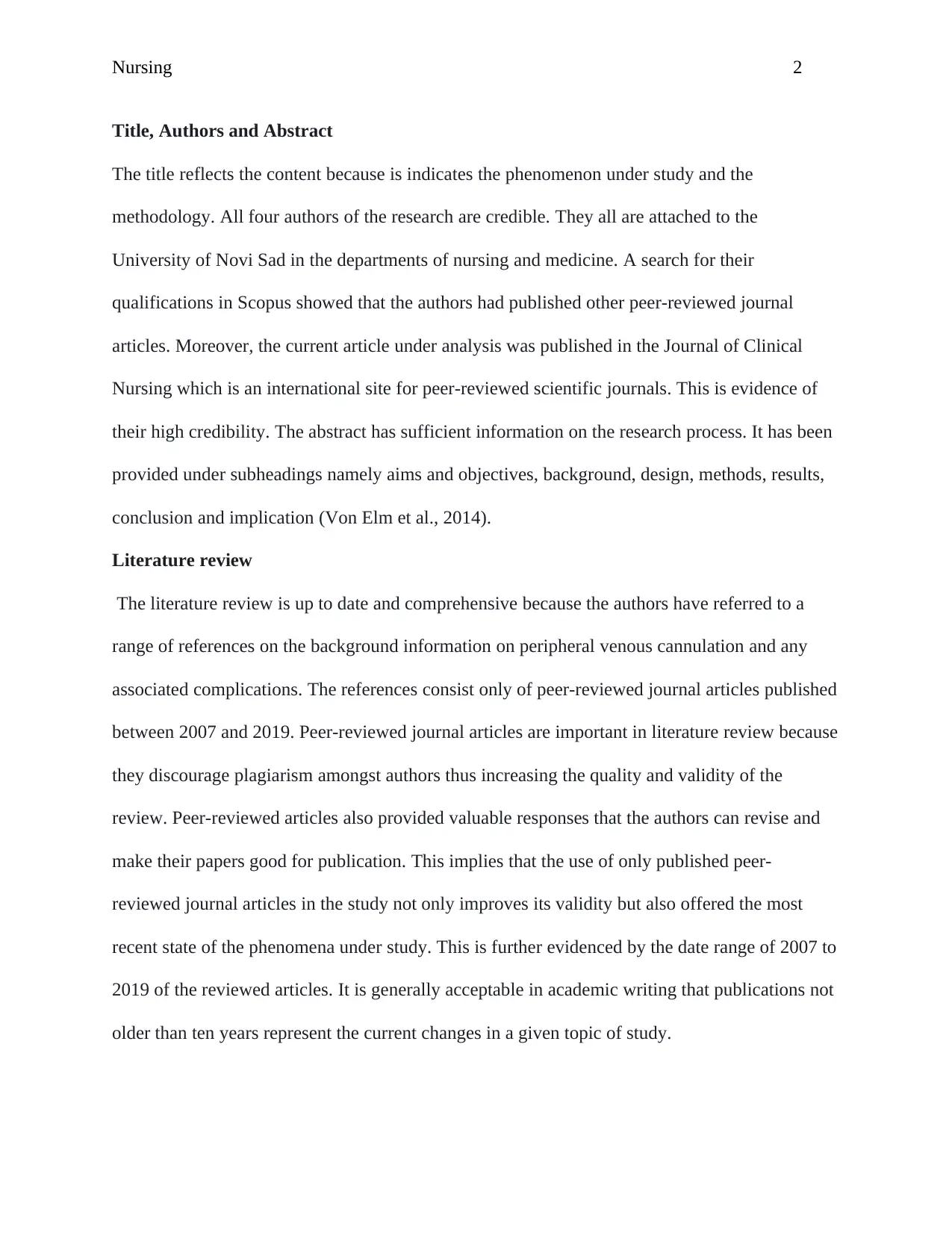
Nursing 2
Title, Authors and Abstract
The title reflects the content because is indicates the phenomenon under study and the
methodology. All four authors of the research are credible. They all are attached to the
University of Novi Sad in the departments of nursing and medicine. A search for their
qualifications in Scopus showed that the authors had published other peer-reviewed journal
articles. Moreover, the current article under analysis was published in the Journal of Clinical
Nursing which is an international site for peer-reviewed scientific journals. This is evidence of
their high credibility. The abstract has sufficient information on the research process. It has been
provided under subheadings namely aims and objectives, background, design, methods, results,
conclusion and implication (Von Elm et al., 2014).
Literature review
The literature review is up to date and comprehensive because the authors have referred to a
range of references on the background information on peripheral venous cannulation and any
associated complications. The references consist only of peer-reviewed journal articles published
between 2007 and 2019. Peer-reviewed journal articles are important in literature review because
they discourage plagiarism amongst authors thus increasing the quality and validity of the
review. Peer-reviewed articles also provided valuable responses that the authors can revise and
make their papers good for publication. This implies that the use of only published peer-
reviewed journal articles in the study not only improves its validity but also offered the most
recent state of the phenomena under study. This is further evidenced by the date range of 2007 to
2019 of the reviewed articles. It is generally acceptable in academic writing that publications not
older than ten years represent the current changes in a given topic of study.
Title, Authors and Abstract
The title reflects the content because is indicates the phenomenon under study and the
methodology. All four authors of the research are credible. They all are attached to the
University of Novi Sad in the departments of nursing and medicine. A search for their
qualifications in Scopus showed that the authors had published other peer-reviewed journal
articles. Moreover, the current article under analysis was published in the Journal of Clinical
Nursing which is an international site for peer-reviewed scientific journals. This is evidence of
their high credibility. The abstract has sufficient information on the research process. It has been
provided under subheadings namely aims and objectives, background, design, methods, results,
conclusion and implication (Von Elm et al., 2014).
Literature review
The literature review is up to date and comprehensive because the authors have referred to a
range of references on the background information on peripheral venous cannulation and any
associated complications. The references consist only of peer-reviewed journal articles published
between 2007 and 2019. Peer-reviewed journal articles are important in literature review because
they discourage plagiarism amongst authors thus increasing the quality and validity of the
review. Peer-reviewed articles also provided valuable responses that the authors can revise and
make their papers good for publication. This implies that the use of only published peer-
reviewed journal articles in the study not only improves its validity but also offered the most
recent state of the phenomena under study. This is further evidenced by the date range of 2007 to
2019 of the reviewed articles. It is generally acceptable in academic writing that publications not
older than ten years represent the current changes in a given topic of study.

Nursing 3
Additionally, the use of STROBE guidelines ensured that the selected articles were relevant to
the study topic. STROBE guidelines are effective in assessing the strengths and weaknesses of
studies for inclusion or exclusion from the review. The study has identified and stated the gaps in
the existing literature. There is limited literature on PVC management in different regions and
underreporting of local complications except for the factors leading to premature removal of
PVC. There is also an underestimation of the PVC complications that are reported due to the
common use of a retrospective medical chart that is affected by poor documentation (Carr et al.,
2016). The aim of the study has also been stated which is to identify the common local
complications of IV therapy administered through PVC.
Quantitative data collection
Questionnaires were used to collect data regarding the patient medical data in addition to age,
sex, BMI, main hand, disabilities associated with diabetes mellitus, smoking behaviours, distress
due to PVC among others. Questionnaires are appropriate for the observational prospective study
because they can be used to easily reach a large population. Moreover, a standard questionnaire
makes it possible to quantify answers for a research topic thus making it relatively easy to
compare the results and to analyze. Questionnaires are also effective in the collection of data in
the prospective observational study because data is collected in intervals during the period of
observation, thus ensuring that no observed data is missed or lost (Krosnick, 2018). However,
questionnaires usually allow a limited choice of feedbacks and if the right response is missing
among the answers, the information obtained will be invalid (Song, & Chung, 2010).
Data collection was carried out by nurses and one researcher. The nurse gathered data on cannula
placement and recorded it after the sign for the PVC placement was included after cannulation,
PVC catheter size, the number of attempts among others. A daily researcher also collected data
Additionally, the use of STROBE guidelines ensured that the selected articles were relevant to
the study topic. STROBE guidelines are effective in assessing the strengths and weaknesses of
studies for inclusion or exclusion from the review. The study has identified and stated the gaps in
the existing literature. There is limited literature on PVC management in different regions and
underreporting of local complications except for the factors leading to premature removal of
PVC. There is also an underestimation of the PVC complications that are reported due to the
common use of a retrospective medical chart that is affected by poor documentation (Carr et al.,
2016). The aim of the study has also been stated which is to identify the common local
complications of IV therapy administered through PVC.
Quantitative data collection
Questionnaires were used to collect data regarding the patient medical data in addition to age,
sex, BMI, main hand, disabilities associated with diabetes mellitus, smoking behaviours, distress
due to PVC among others. Questionnaires are appropriate for the observational prospective study
because they can be used to easily reach a large population. Moreover, a standard questionnaire
makes it possible to quantify answers for a research topic thus making it relatively easy to
compare the results and to analyze. Questionnaires are also effective in the collection of data in
the prospective observational study because data is collected in intervals during the period of
observation, thus ensuring that no observed data is missed or lost (Krosnick, 2018). However,
questionnaires usually allow a limited choice of feedbacks and if the right response is missing
among the answers, the information obtained will be invalid (Song, & Chung, 2010).
Data collection was carried out by nurses and one researcher. The nurse gathered data on cannula
placement and recorded it after the sign for the PVC placement was included after cannulation,
PVC catheter size, the number of attempts among others. A daily researcher also collected data
⊘ This is a preview!⊘
Do you want full access?
Subscribe today to unlock all pages.

Trusted by 1+ million students worldwide
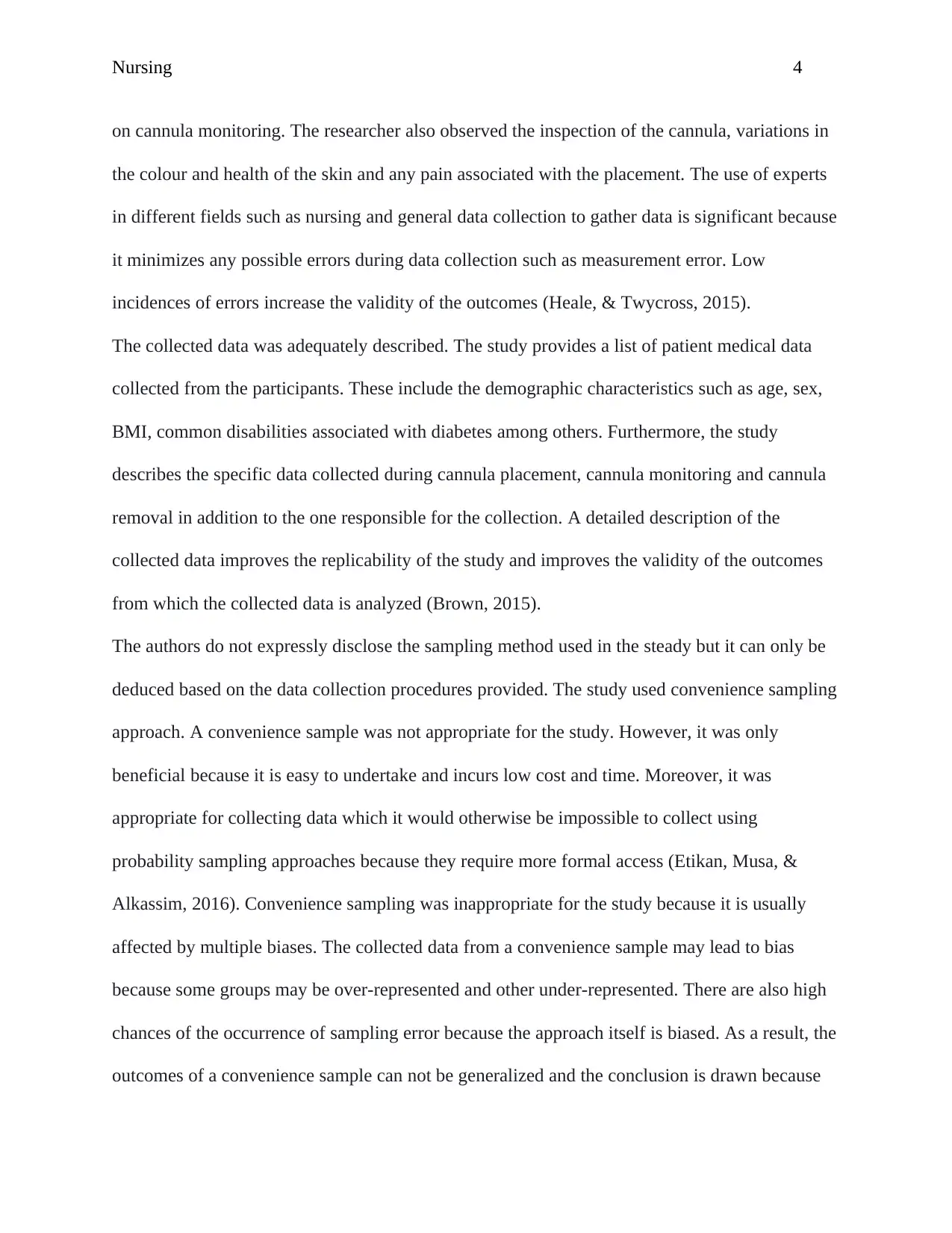
Nursing 4
on cannula monitoring. The researcher also observed the inspection of the cannula, variations in
the colour and health of the skin and any pain associated with the placement. The use of experts
in different fields such as nursing and general data collection to gather data is significant because
it minimizes any possible errors during data collection such as measurement error. Low
incidences of errors increase the validity of the outcomes (Heale, & Twycross, 2015).
The collected data was adequately described. The study provides a list of patient medical data
collected from the participants. These include the demographic characteristics such as age, sex,
BMI, common disabilities associated with diabetes among others. Furthermore, the study
describes the specific data collected during cannula placement, cannula monitoring and cannula
removal in addition to the one responsible for the collection. A detailed description of the
collected data improves the replicability of the study and improves the validity of the outcomes
from which the collected data is analyzed (Brown, 2015).
The authors do not expressly disclose the sampling method used in the steady but it can only be
deduced based on the data collection procedures provided. The study used convenience sampling
approach. A convenience sample was not appropriate for the study. However, it was only
beneficial because it is easy to undertake and incurs low cost and time. Moreover, it was
appropriate for collecting data which it would otherwise be impossible to collect using
probability sampling approaches because they require more formal access (Etikan, Musa, &
Alkassim, 2016). Convenience sampling was inappropriate for the study because it is usually
affected by multiple biases. The collected data from a convenience sample may lead to bias
because some groups may be over-represented and other under-represented. There are also high
chances of the occurrence of sampling error because the approach itself is biased. As a result, the
outcomes of a convenience sample can not be generalized and the conclusion is drawn because
on cannula monitoring. The researcher also observed the inspection of the cannula, variations in
the colour and health of the skin and any pain associated with the placement. The use of experts
in different fields such as nursing and general data collection to gather data is significant because
it minimizes any possible errors during data collection such as measurement error. Low
incidences of errors increase the validity of the outcomes (Heale, & Twycross, 2015).
The collected data was adequately described. The study provides a list of patient medical data
collected from the participants. These include the demographic characteristics such as age, sex,
BMI, common disabilities associated with diabetes among others. Furthermore, the study
describes the specific data collected during cannula placement, cannula monitoring and cannula
removal in addition to the one responsible for the collection. A detailed description of the
collected data improves the replicability of the study and improves the validity of the outcomes
from which the collected data is analyzed (Brown, 2015).
The authors do not expressly disclose the sampling method used in the steady but it can only be
deduced based on the data collection procedures provided. The study used convenience sampling
approach. A convenience sample was not appropriate for the study. However, it was only
beneficial because it is easy to undertake and incurs low cost and time. Moreover, it was
appropriate for collecting data which it would otherwise be impossible to collect using
probability sampling approaches because they require more formal access (Etikan, Musa, &
Alkassim, 2016). Convenience sampling was inappropriate for the study because it is usually
affected by multiple biases. The collected data from a convenience sample may lead to bias
because some groups may be over-represented and other under-represented. There are also high
chances of the occurrence of sampling error because the approach itself is biased. As a result, the
outcomes of a convenience sample can not be generalized and the conclusion is drawn because
Paraphrase This Document
Need a fresh take? Get an instant paraphrase of this document with our AI Paraphraser
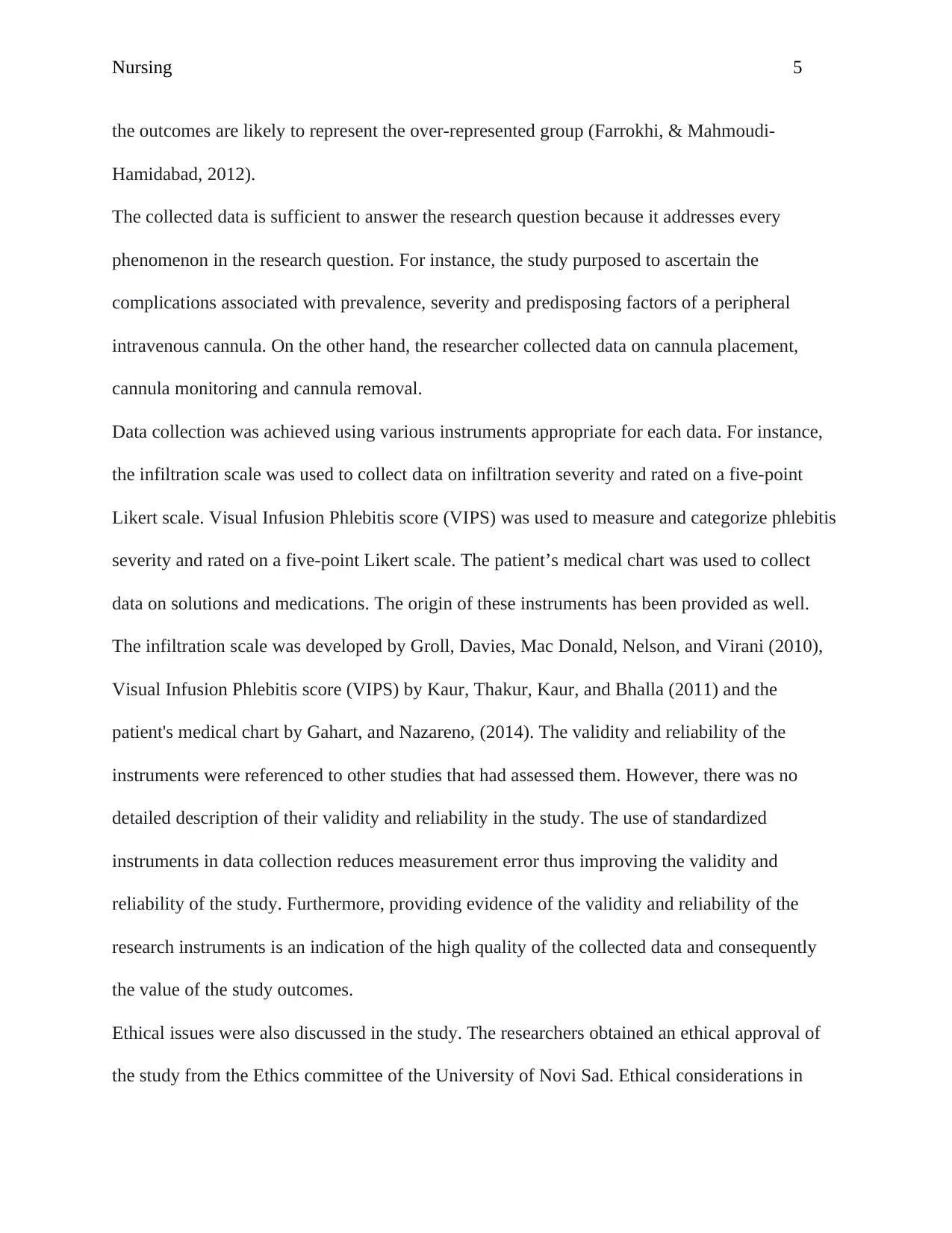
Nursing 5
the outcomes are likely to represent the over-represented group (Farrokhi, & Mahmoudi-
Hamidabad, 2012).
The collected data is sufficient to answer the research question because it addresses every
phenomenon in the research question. For instance, the study purposed to ascertain the
complications associated with prevalence, severity and predisposing factors of a peripheral
intravenous cannula. On the other hand, the researcher collected data on cannula placement,
cannula monitoring and cannula removal.
Data collection was achieved using various instruments appropriate for each data. For instance,
the infiltration scale was used to collect data on infiltration severity and rated on a five-point
Likert scale. Visual Infusion Phlebitis score (VIPS) was used to measure and categorize phlebitis
severity and rated on a five-point Likert scale. The patient’s medical chart was used to collect
data on solutions and medications. The origin of these instruments has been provided as well.
The infiltration scale was developed by Groll, Davies, Mac Donald, Nelson, and Virani (2010),
Visual Infusion Phlebitis score (VIPS) by Kaur, Thakur, Kaur, and Bhalla (2011) and the
patient's medical chart by Gahart, and Nazareno, (2014). The validity and reliability of the
instruments were referenced to other studies that had assessed them. However, there was no
detailed description of their validity and reliability in the study. The use of standardized
instruments in data collection reduces measurement error thus improving the validity and
reliability of the study. Furthermore, providing evidence of the validity and reliability of the
research instruments is an indication of the high quality of the collected data and consequently
the value of the study outcomes.
Ethical issues were also discussed in the study. The researchers obtained an ethical approval of
the study from the Ethics committee of the University of Novi Sad. Ethical considerations in
the outcomes are likely to represent the over-represented group (Farrokhi, & Mahmoudi-
Hamidabad, 2012).
The collected data is sufficient to answer the research question because it addresses every
phenomenon in the research question. For instance, the study purposed to ascertain the
complications associated with prevalence, severity and predisposing factors of a peripheral
intravenous cannula. On the other hand, the researcher collected data on cannula placement,
cannula monitoring and cannula removal.
Data collection was achieved using various instruments appropriate for each data. For instance,
the infiltration scale was used to collect data on infiltration severity and rated on a five-point
Likert scale. Visual Infusion Phlebitis score (VIPS) was used to measure and categorize phlebitis
severity and rated on a five-point Likert scale. The patient’s medical chart was used to collect
data on solutions and medications. The origin of these instruments has been provided as well.
The infiltration scale was developed by Groll, Davies, Mac Donald, Nelson, and Virani (2010),
Visual Infusion Phlebitis score (VIPS) by Kaur, Thakur, Kaur, and Bhalla (2011) and the
patient's medical chart by Gahart, and Nazareno, (2014). The validity and reliability of the
instruments were referenced to other studies that had assessed them. However, there was no
detailed description of their validity and reliability in the study. The use of standardized
instruments in data collection reduces measurement error thus improving the validity and
reliability of the study. Furthermore, providing evidence of the validity and reliability of the
research instruments is an indication of the high quality of the collected data and consequently
the value of the study outcomes.
Ethical issues were also discussed in the study. The researchers obtained an ethical approval of
the study from the Ethics committee of the University of Novi Sad. Ethical considerations in
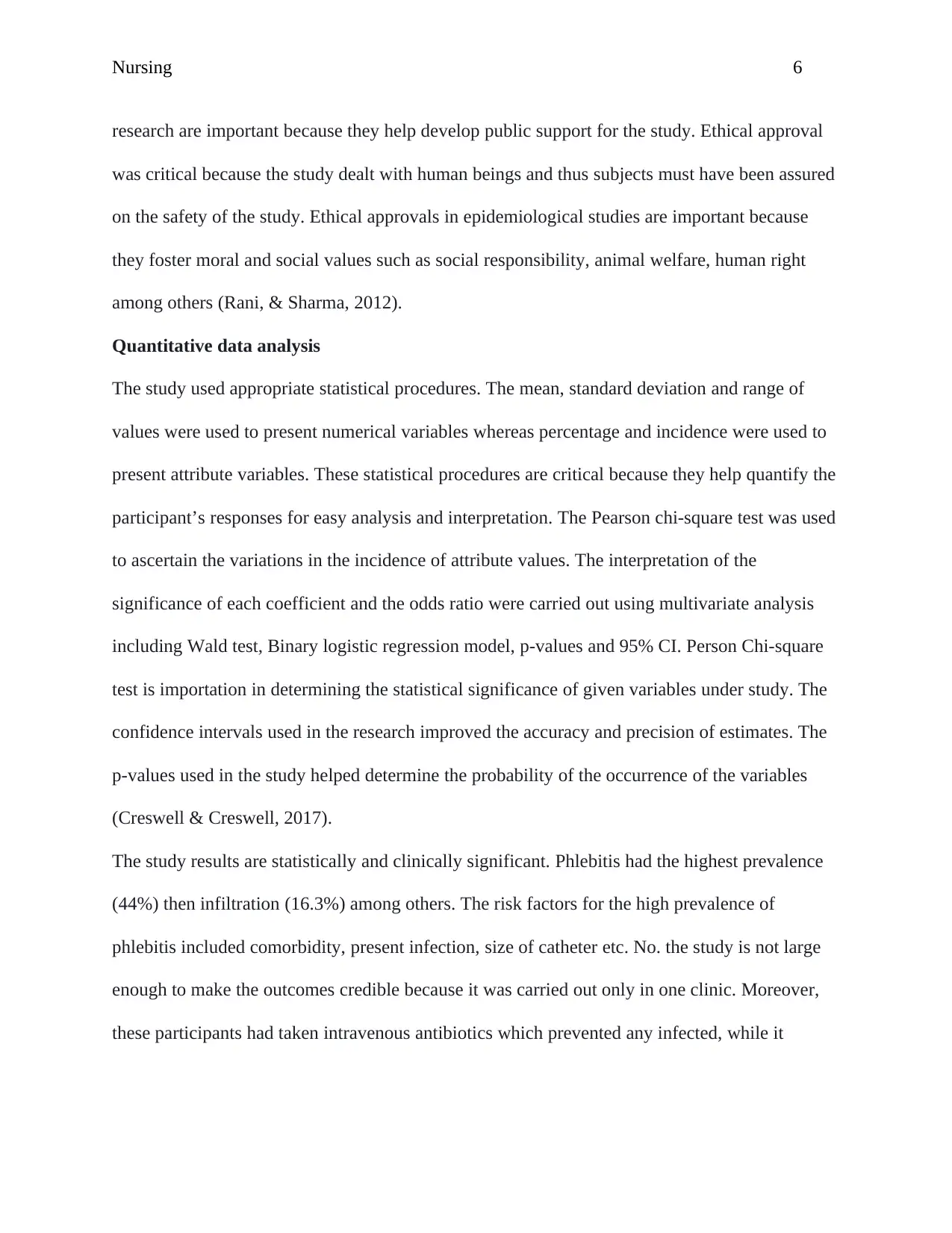
Nursing 6
research are important because they help develop public support for the study. Ethical approval
was critical because the study dealt with human beings and thus subjects must have been assured
on the safety of the study. Ethical approvals in epidemiological studies are important because
they foster moral and social values such as social responsibility, animal welfare, human right
among others (Rani, & Sharma, 2012).
Quantitative data analysis
The study used appropriate statistical procedures. The mean, standard deviation and range of
values were used to present numerical variables whereas percentage and incidence were used to
present attribute variables. These statistical procedures are critical because they help quantify the
participant’s responses for easy analysis and interpretation. The Pearson chi‐square test was used
to ascertain the variations in the incidence of attribute values. The interpretation of the
significance of each coefficient and the odds ratio were carried out using multivariate analysis
including Wald test, Binary logistic regression model, p-values and 95% CI. Person Chi-square
test is importation in determining the statistical significance of given variables under study. The
confidence intervals used in the research improved the accuracy and precision of estimates. The
p-values used in the study helped determine the probability of the occurrence of the variables
(Creswell & Creswell, 2017).
The study results are statistically and clinically significant. Phlebitis had the highest prevalence
(44%) then infiltration (16.3%) among others. The risk factors for the high prevalence of
phlebitis included comorbidity, present infection, size of catheter etc. No. the study is not large
enough to make the outcomes credible because it was carried out only in one clinic. Moreover,
these participants had taken intravenous antibiotics which prevented any infected, while it
research are important because they help develop public support for the study. Ethical approval
was critical because the study dealt with human beings and thus subjects must have been assured
on the safety of the study. Ethical approvals in epidemiological studies are important because
they foster moral and social values such as social responsibility, animal welfare, human right
among others (Rani, & Sharma, 2012).
Quantitative data analysis
The study used appropriate statistical procedures. The mean, standard deviation and range of
values were used to present numerical variables whereas percentage and incidence were used to
present attribute variables. These statistical procedures are critical because they help quantify the
participant’s responses for easy analysis and interpretation. The Pearson chi‐square test was used
to ascertain the variations in the incidence of attribute values. The interpretation of the
significance of each coefficient and the odds ratio were carried out using multivariate analysis
including Wald test, Binary logistic regression model, p-values and 95% CI. Person Chi-square
test is importation in determining the statistical significance of given variables under study. The
confidence intervals used in the research improved the accuracy and precision of estimates. The
p-values used in the study helped determine the probability of the occurrence of the variables
(Creswell & Creswell, 2017).
The study results are statistically and clinically significant. Phlebitis had the highest prevalence
(44%) then infiltration (16.3%) among others. The risk factors for the high prevalence of
phlebitis included comorbidity, present infection, size of catheter etc. No. the study is not large
enough to make the outcomes credible because it was carried out only in one clinic. Moreover,
these participants had taken intravenous antibiotics which prevented any infected, while it
⊘ This is a preview!⊘
Do you want full access?
Subscribe today to unlock all pages.

Trusted by 1+ million students worldwide
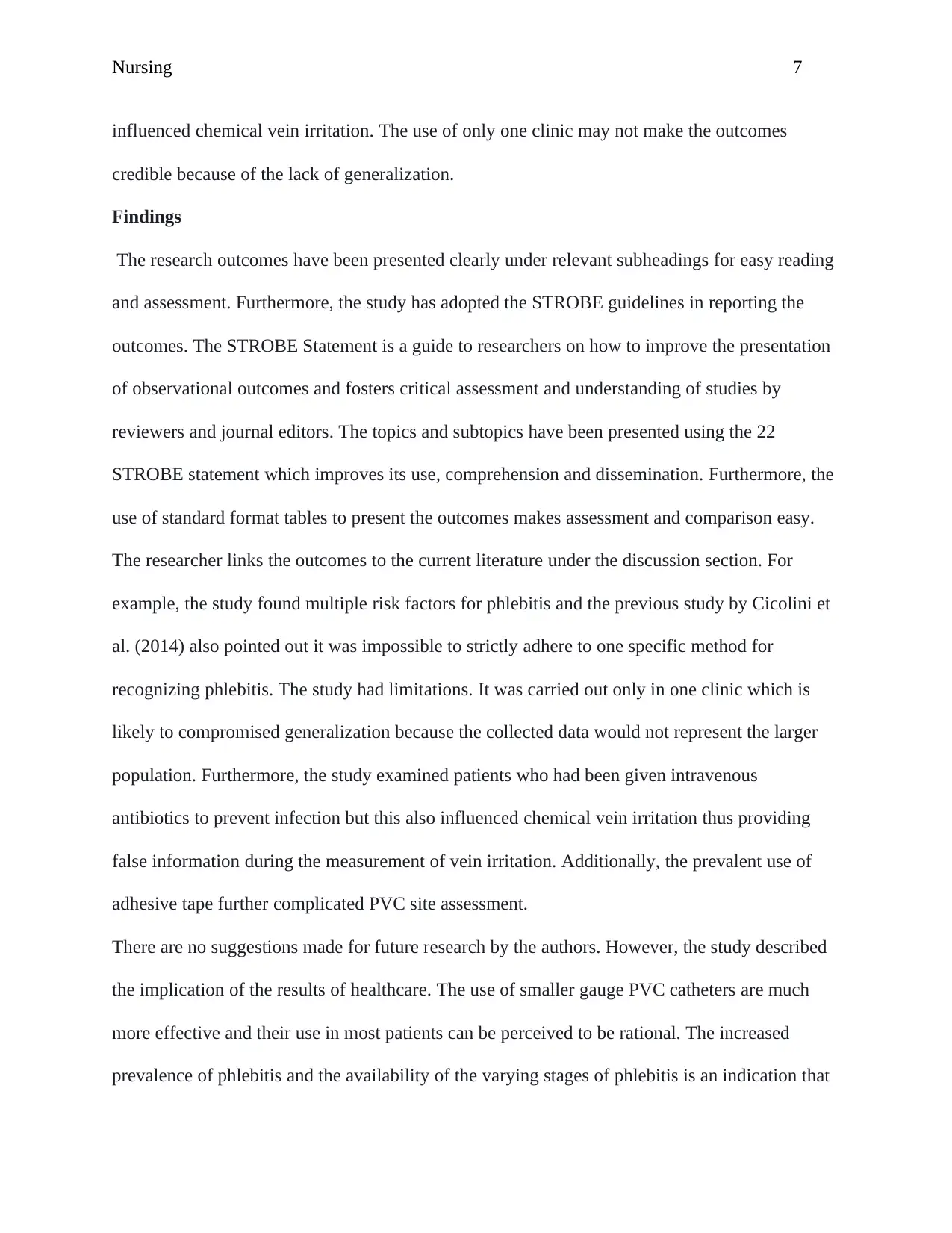
Nursing 7
influenced chemical vein irritation. The use of only one clinic may not make the outcomes
credible because of the lack of generalization.
Findings
The research outcomes have been presented clearly under relevant subheadings for easy reading
and assessment. Furthermore, the study has adopted the STROBE guidelines in reporting the
outcomes. The STROBE Statement is a guide to researchers on how to improve the presentation
of observational outcomes and fosters critical assessment and understanding of studies by
reviewers and journal editors. The topics and subtopics have been presented using the 22
STROBE statement which improves its use, comprehension and dissemination. Furthermore, the
use of standard format tables to present the outcomes makes assessment and comparison easy.
The researcher links the outcomes to the current literature under the discussion section. For
example, the study found multiple risk factors for phlebitis and the previous study by Cicolini et
al. (2014) also pointed out it was impossible to strictly adhere to one specific method for
recognizing phlebitis. The study had limitations. It was carried out only in one clinic which is
likely to compromised generalization because the collected data would not represent the larger
population. Furthermore, the study examined patients who had been given intravenous
antibiotics to prevent infection but this also influenced chemical vein irritation thus providing
false information during the measurement of vein irritation. Additionally, the prevalent use of
adhesive tape further complicated PVC site assessment.
There are no suggestions made for future research by the authors. However, the study described
the implication of the results of healthcare. The use of smaller gauge PVC catheters are much
more effective and their use in most patients can be perceived to be rational. The increased
prevalence of phlebitis and the availability of the varying stages of phlebitis is an indication that
influenced chemical vein irritation. The use of only one clinic may not make the outcomes
credible because of the lack of generalization.
Findings
The research outcomes have been presented clearly under relevant subheadings for easy reading
and assessment. Furthermore, the study has adopted the STROBE guidelines in reporting the
outcomes. The STROBE Statement is a guide to researchers on how to improve the presentation
of observational outcomes and fosters critical assessment and understanding of studies by
reviewers and journal editors. The topics and subtopics have been presented using the 22
STROBE statement which improves its use, comprehension and dissemination. Furthermore, the
use of standard format tables to present the outcomes makes assessment and comparison easy.
The researcher links the outcomes to the current literature under the discussion section. For
example, the study found multiple risk factors for phlebitis and the previous study by Cicolini et
al. (2014) also pointed out it was impossible to strictly adhere to one specific method for
recognizing phlebitis. The study had limitations. It was carried out only in one clinic which is
likely to compromised generalization because the collected data would not represent the larger
population. Furthermore, the study examined patients who had been given intravenous
antibiotics to prevent infection but this also influenced chemical vein irritation thus providing
false information during the measurement of vein irritation. Additionally, the prevalent use of
adhesive tape further complicated PVC site assessment.
There are no suggestions made for future research by the authors. However, the study described
the implication of the results of healthcare. The use of smaller gauge PVC catheters are much
more effective and their use in most patients can be perceived to be rational. The increased
prevalence of phlebitis and the availability of the varying stages of phlebitis is an indication that
Paraphrase This Document
Need a fresh take? Get an instant paraphrase of this document with our AI Paraphraser

Nursing 8
it is essential to contemplate corrective measures that incorporate standardization of guidelines
associated to PVC insertion, in addition to educational campaigns (Simin, Milutinović, Turkulov,
& Brkić, 2019). There is a need for extra financial resources in the daily application of vein
visualization agents, PVC made of materials with minimal cases of irritation and transparent
dressings. The findings can be generalized to relatively similar population characteristics but
with cautions considerations of the underlying limits. The researchers examined only one clinic
thus making it difficult to generalize the outcomes to a larger population. Moreover, convenience
sampling is likely to overestimate or underestimate the sample size and thus lead to selection
bias. This further makes the generalization difficult because the sample may only represent the
view of some group of participants. However, the results can be transferred or replicated due to
the detailed methodical approach given in the study (Polit, & Beck, 2010).
Conclusion of the article
The conclusion of the article is comprehensive. It first re-states the current status of the study
phenomena and relevant background information, then a summary of the findings are given and
lastly an answer to the research question based on the outcomes.
it is essential to contemplate corrective measures that incorporate standardization of guidelines
associated to PVC insertion, in addition to educational campaigns (Simin, Milutinović, Turkulov,
& Brkić, 2019). There is a need for extra financial resources in the daily application of vein
visualization agents, PVC made of materials with minimal cases of irritation and transparent
dressings. The findings can be generalized to relatively similar population characteristics but
with cautions considerations of the underlying limits. The researchers examined only one clinic
thus making it difficult to generalize the outcomes to a larger population. Moreover, convenience
sampling is likely to overestimate or underestimate the sample size and thus lead to selection
bias. This further makes the generalization difficult because the sample may only represent the
view of some group of participants. However, the results can be transferred or replicated due to
the detailed methodical approach given in the study (Polit, & Beck, 2010).
Conclusion of the article
The conclusion of the article is comprehensive. It first re-states the current status of the study
phenomena and relevant background information, then a summary of the findings are given and
lastly an answer to the research question based on the outcomes.

Nursing 9
References
Brown, J. D. (2015). Characteristics of sound quantitative research. Shiken, 19(2), 1-28.
Carr, P. J., Rippey, J., Moore, T., Ngo, H., Cooke, M. L., Higgins, N. S., & Rickard, C. M.
(2016). Reasons for removal of emergency department–inserted peripheral intravenous
cannulae in admitted patients: A retrospective medical chart audit in Australia. infection
control & hospital epidemiology, 37(7), 874-876.
Cicolini, G., Manzoli, L., Simonetti, V., Flacco, M. E., Comparcini, D., Capasso, L., ... & Eltaji
Elfarouki, G. (2014). Phlebitis risk varies by peripheral venous catheter site and increases
after 96 hours: a large multi‐centre prospective study. Journal of advanced
nursing, 70(11), 2539-2549.
Creswell, J. W., & Creswell, J. D. (2017). Research design: Qualitative, quantitative, and mixed
methods approaches (2nd ed.). Sage publications.
Etikan, I., Musa, S. A., & Alkassim, R. S. (2016). Comparison of convenience sampling and
purposive sampling. American journal of theoretical and applied statistics, 5(1), 1-4.
Farrokhi, F., & Mahmoudi-Hamidabad, A. (2012). Rethinking Convenience Sampling: Defining
Quality Criteria. Theory & Practice in Language Studies, 2(4).
Gahart, B. L., & Nazareno, A. R. (2014). Intravenous Medications: A Handbook for Nurses and
Health Professionals; Intravenous Medications (30th ed.). Elsevier, NY: New York.
Groll, D., Davies, B., Mac Donald, J., Nelson, S., & Virani, T. (2010). Evaluation of the
References
Brown, J. D. (2015). Characteristics of sound quantitative research. Shiken, 19(2), 1-28.
Carr, P. J., Rippey, J., Moore, T., Ngo, H., Cooke, M. L., Higgins, N. S., & Rickard, C. M.
(2016). Reasons for removal of emergency department–inserted peripheral intravenous
cannulae in admitted patients: A retrospective medical chart audit in Australia. infection
control & hospital epidemiology, 37(7), 874-876.
Cicolini, G., Manzoli, L., Simonetti, V., Flacco, M. E., Comparcini, D., Capasso, L., ... & Eltaji
Elfarouki, G. (2014). Phlebitis risk varies by peripheral venous catheter site and increases
after 96 hours: a large multi‐centre prospective study. Journal of advanced
nursing, 70(11), 2539-2549.
Creswell, J. W., & Creswell, J. D. (2017). Research design: Qualitative, quantitative, and mixed
methods approaches (2nd ed.). Sage publications.
Etikan, I., Musa, S. A., & Alkassim, R. S. (2016). Comparison of convenience sampling and
purposive sampling. American journal of theoretical and applied statistics, 5(1), 1-4.
Farrokhi, F., & Mahmoudi-Hamidabad, A. (2012). Rethinking Convenience Sampling: Defining
Quality Criteria. Theory & Practice in Language Studies, 2(4).
Gahart, B. L., & Nazareno, A. R. (2014). Intravenous Medications: A Handbook for Nurses and
Health Professionals; Intravenous Medications (30th ed.). Elsevier, NY: New York.
Groll, D., Davies, B., Mac Donald, J., Nelson, S., & Virani, T. (2010). Evaluation of the
⊘ This is a preview!⊘
Do you want full access?
Subscribe today to unlock all pages.

Trusted by 1+ million students worldwide
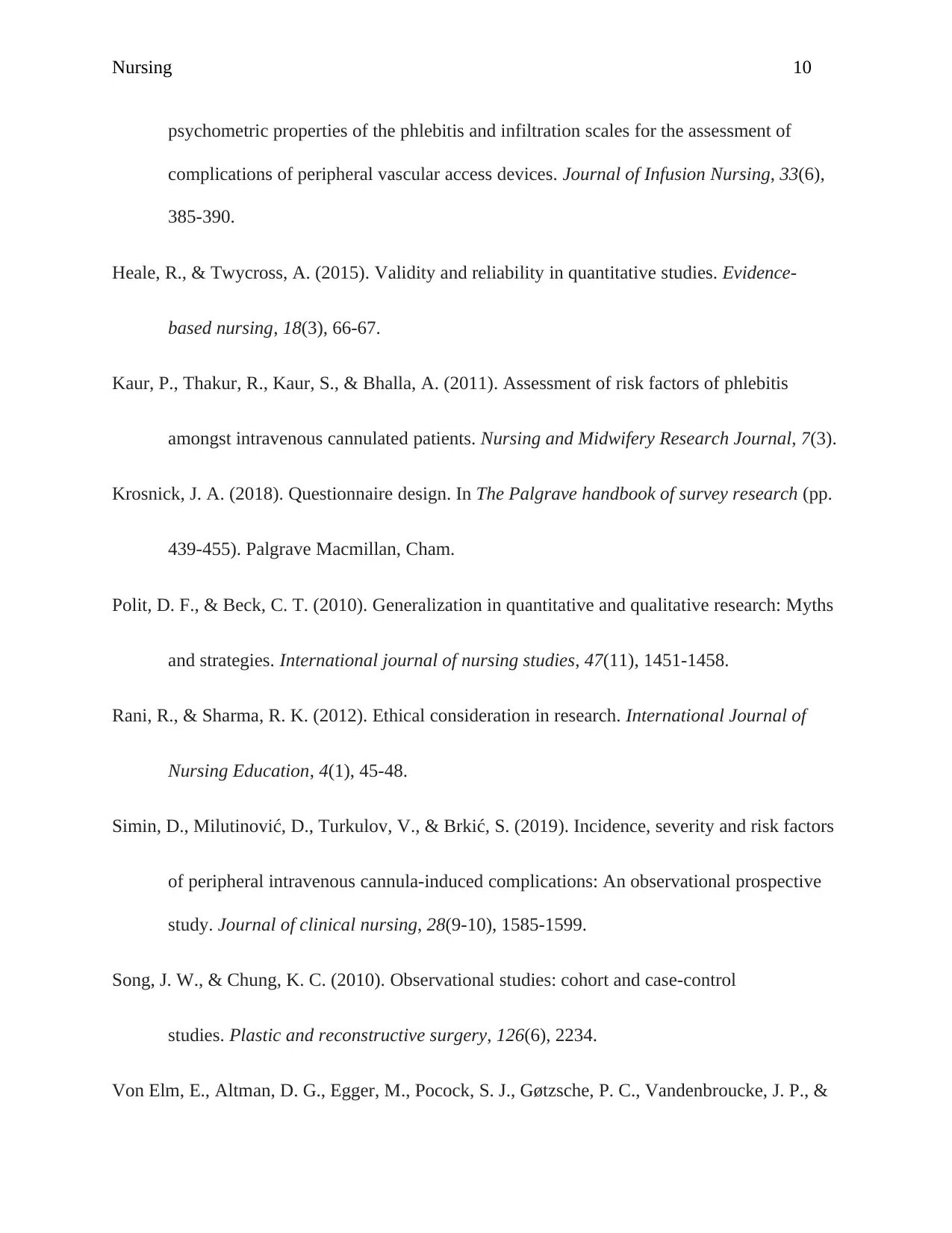
Nursing 10
psychometric properties of the phlebitis and infiltration scales for the assessment of
complications of peripheral vascular access devices. Journal of Infusion Nursing, 33(6),
385-390.
Heale, R., & Twycross, A. (2015). Validity and reliability in quantitative studies. Evidence-
based nursing, 18(3), 66-67.
Kaur, P., Thakur, R., Kaur, S., & Bhalla, A. (2011). Assessment of risk factors of phlebitis
amongst intravenous cannulated patients. Nursing and Midwifery Research Journal, 7(3).
Krosnick, J. A. (2018). Questionnaire design. In The Palgrave handbook of survey research (pp.
439-455). Palgrave Macmillan, Cham.
Polit, D. F., & Beck, C. T. (2010). Generalization in quantitative and qualitative research: Myths
and strategies. International journal of nursing studies, 47(11), 1451-1458.
Rani, R., & Sharma, R. K. (2012). Ethical consideration in research. International Journal of
Nursing Education, 4(1), 45-48.
Simin, D., Milutinović, D., Turkulov, V., & Brkić, S. (2019). Incidence, severity and risk factors
of peripheral intravenous cannula‐induced complications: An observational prospective
study. Journal of clinical nursing, 28(9-10), 1585-1599.
Song, J. W., & Chung, K. C. (2010). Observational studies: cohort and case-control
studies. Plastic and reconstructive surgery, 126(6), 2234.
Von Elm, E., Altman, D. G., Egger, M., Pocock, S. J., Gøtzsche, P. C., Vandenbroucke, J. P., &
psychometric properties of the phlebitis and infiltration scales for the assessment of
complications of peripheral vascular access devices. Journal of Infusion Nursing, 33(6),
385-390.
Heale, R., & Twycross, A. (2015). Validity and reliability in quantitative studies. Evidence-
based nursing, 18(3), 66-67.
Kaur, P., Thakur, R., Kaur, S., & Bhalla, A. (2011). Assessment of risk factors of phlebitis
amongst intravenous cannulated patients. Nursing and Midwifery Research Journal, 7(3).
Krosnick, J. A. (2018). Questionnaire design. In The Palgrave handbook of survey research (pp.
439-455). Palgrave Macmillan, Cham.
Polit, D. F., & Beck, C. T. (2010). Generalization in quantitative and qualitative research: Myths
and strategies. International journal of nursing studies, 47(11), 1451-1458.
Rani, R., & Sharma, R. K. (2012). Ethical consideration in research. International Journal of
Nursing Education, 4(1), 45-48.
Simin, D., Milutinović, D., Turkulov, V., & Brkić, S. (2019). Incidence, severity and risk factors
of peripheral intravenous cannula‐induced complications: An observational prospective
study. Journal of clinical nursing, 28(9-10), 1585-1599.
Song, J. W., & Chung, K. C. (2010). Observational studies: cohort and case-control
studies. Plastic and reconstructive surgery, 126(6), 2234.
Von Elm, E., Altman, D. G., Egger, M., Pocock, S. J., Gøtzsche, P. C., Vandenbroucke, J. P., &
Paraphrase This Document
Need a fresh take? Get an instant paraphrase of this document with our AI Paraphraser

Nursing 11
Strobe Initiative. (2014). The Strengthening the Reporting of Observational Studies in
Epidemiology (STROBE) Statement: guidelines for reporting observational
studies. International journal of surgery, 12(12), 1495-1499.
Strobe Initiative. (2014). The Strengthening the Reporting of Observational Studies in
Epidemiology (STROBE) Statement: guidelines for reporting observational
studies. International journal of surgery, 12(12), 1495-1499.
1 out of 11
Related Documents
Your All-in-One AI-Powered Toolkit for Academic Success.
+13062052269
info@desklib.com
Available 24*7 on WhatsApp / Email
![[object Object]](/_next/static/media/star-bottom.7253800d.svg)
Unlock your academic potential
Copyright © 2020–2025 A2Z Services. All Rights Reserved. Developed and managed by ZUCOL.





